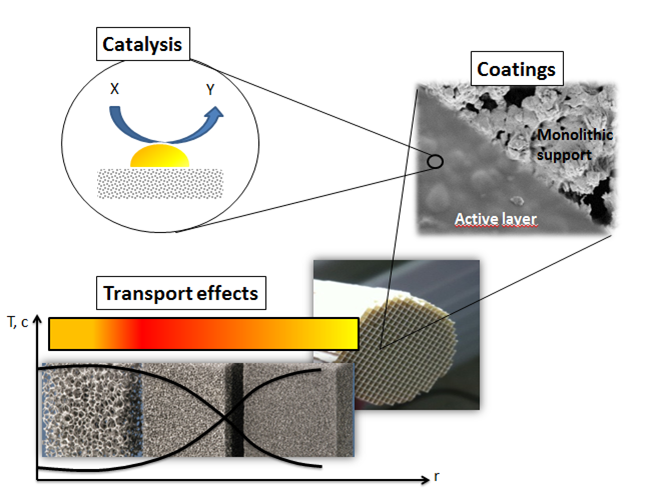
home | staff | research | teaching | lectures/seminars | how to find us | intranet
Deutsch | English

home | staff | research | teaching | lectures/seminars | how to find us | intranet
Deutsch | English
This project is part of the DFG graduate school MIMENIMA. The overall topic is tailoring novel porous ceramic structures and their surfaces for applications in the important fields of energy, environmental, chemical processing and space technology. The project focuses on Sol-Gel coated monoliths and foams for highly exothermic catalytic gas phase reactions. In comparison to conventional pellet catalysts, a lower pressure drop and less heat/mass transport limitations can be realized by using open porous monolithic supports. The primary aim is the preparation and testing of catalysts from Sol-Gel-techniques for the CO2 methanation, Fischer-Tropsch synthesis, and oxidative coupling of methane. In comparison to classical incipient wetness methods, the active phase and the support are directly formed during calcination, leading to benefits such as highly disperse supported particles, special metal-support interactions, and a complex porous network.

Another topic of this project is the investigation of Sol-Gel coatings from on metallic/ceramic monolithic samples and foams. Within the Sol-Gel approach colloidal particles in the nanometer range are stabilized in a proper solvent. From these sols, thin layers with thicknesses in the range of 1 to 10 µm can be produced. In comparison to the conventional suspension approach, the active phase is formed directly on the support, which offers good adhesive properties. In addition, the blocking of pores can be avoided due to the small particle size and the low solid-phase content.
Furthermore, in cooperation with the work group from Prof. Thöming we target the investigation of mass- and heat-transport effects on these coated monolithic samples in a pilot plant. Temperature profiles along the catalysts and the product distribution will be analyzed under reaction conditions for deeper understanding of these reaction limiting conditions.
Miriam Klink, Marcus Bäumer
Cooperation partners: Jorg Thöming, UFT, Universität Bremen; Kurosch Rezwan, Advanced Ceramics Group, Universität Bremen
Funding: DFG
For detailed information contact Marcus Bäumer